Emotions and Motivations in Psychology: A Comprehensive Report
VerifiedAdded on 2023/06/10
|7
|1776
|162
Report
AI Summary
This report provides a comprehensive overview of the key theories of motivation and emotion, exploring their interrelationships and impact on health and personal growth. It begins by defining motivation and emotion, and then delves into prominent theories, including Maslow's hierarchy of needs, Hertzberg's two-factor theory, and the Hawthorne effect for motivation, alongside the James-Lange theory, evolutionary theories, and the facial feedback theory for emotion. The report examines the connections between motivational and emotional theories, highlighting how emotions can serve as incentives and punishments, influencing behavior. Furthermore, it discusses the effects of emotions and motivations on health and personal growth, emphasizing the negative consequences of procrastination and negative emotions, while highlighting the positive impact of positive emotions and motivation on overall well-being. The report concludes by summarizing the key findings and emphasizing the importance of understanding both motivation and emotion for personal development and health.
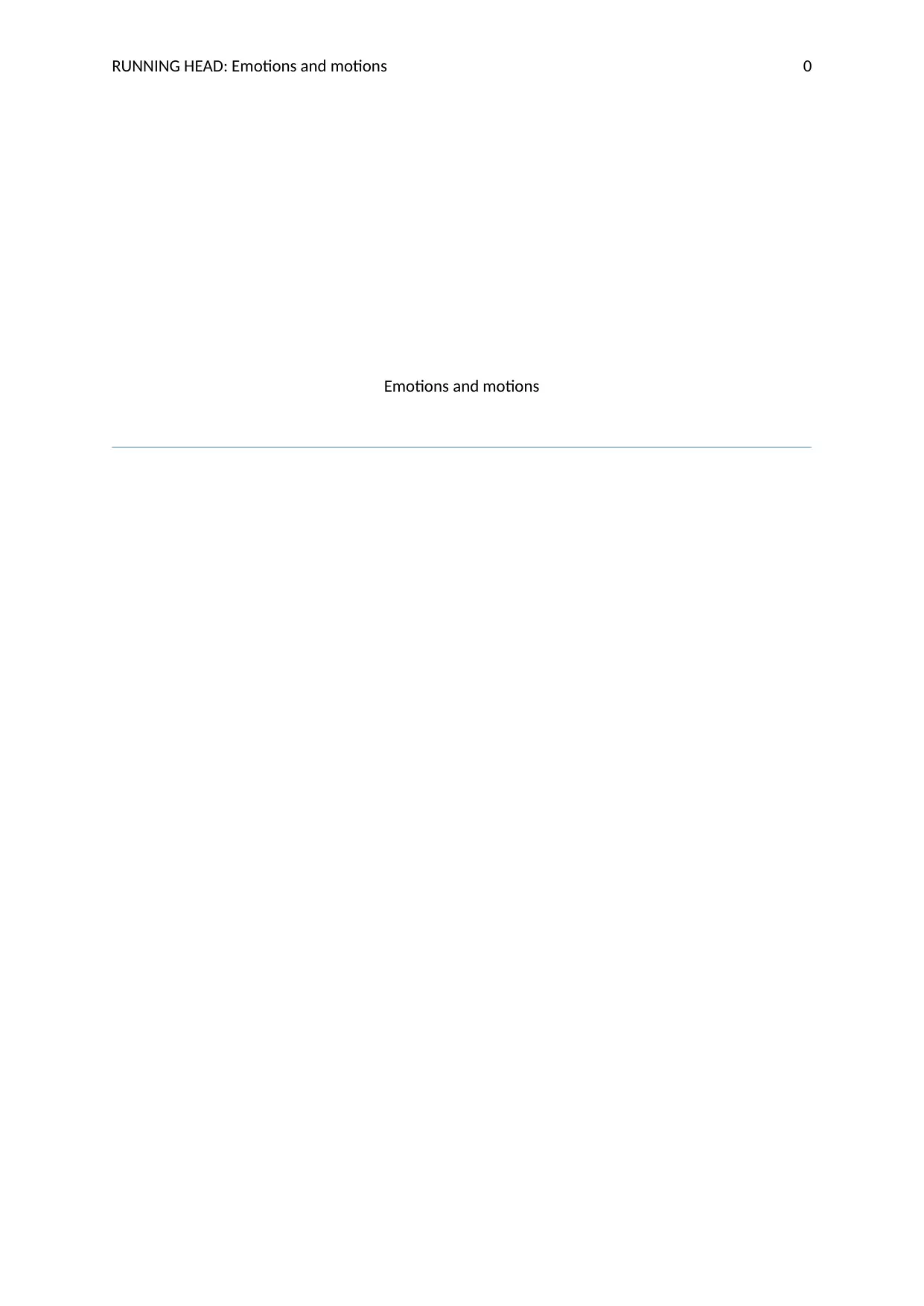
RUNNING HEAD: Emotions and motions 0
Emotions and motions
Emotions and motions
Paraphrase This Document
Need a fresh take? Get an instant paraphrase of this document with our AI Paraphraser
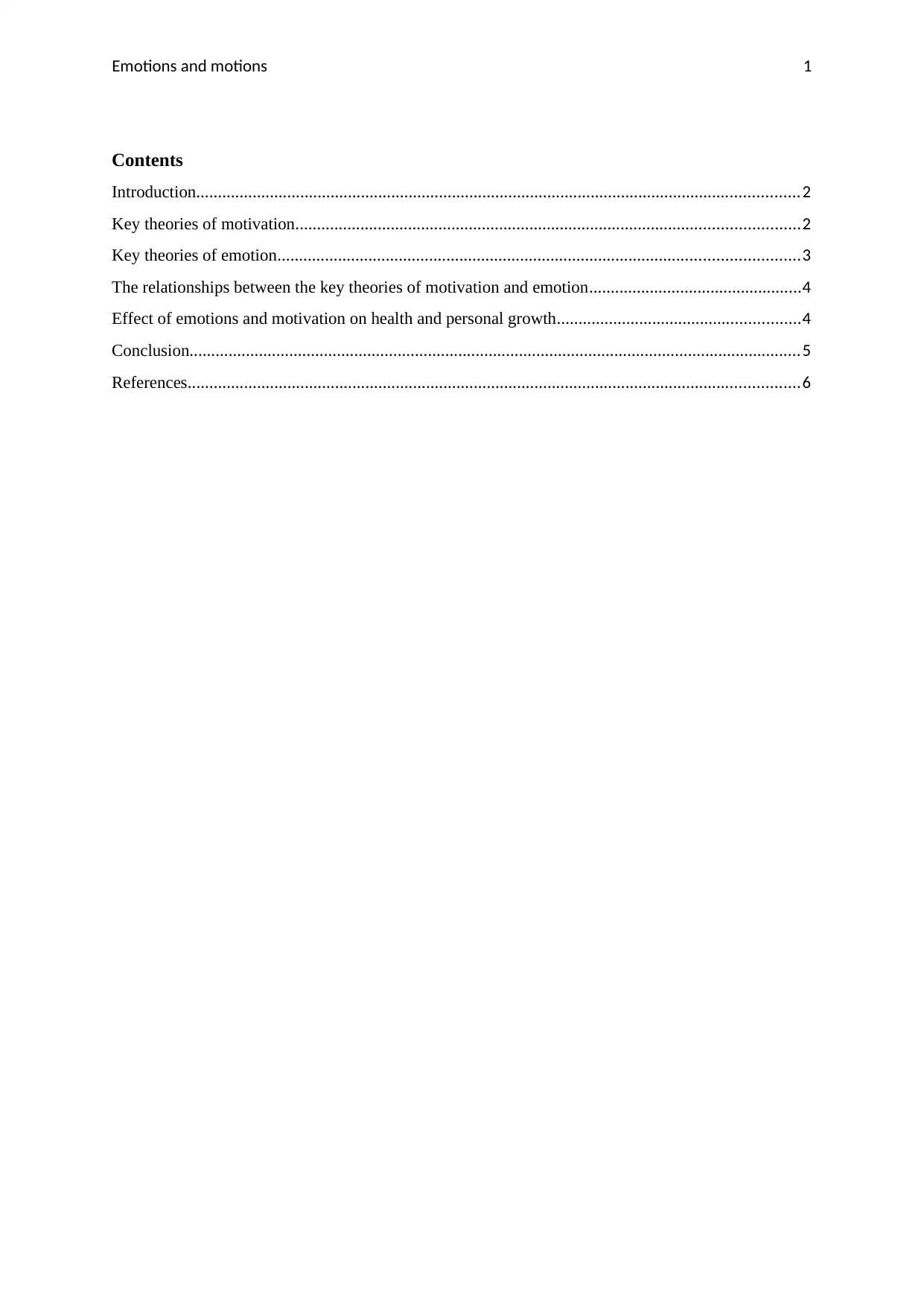
Emotions and motions 1
Contents
Introduction...........................................................................................................................................2
Key theories of motivation....................................................................................................................2
Key theories of emotion........................................................................................................................3
The relationships between the key theories of motivation and emotion.................................................4
Effect of emotions and motivation on health and personal growth........................................................4
Conclusion.............................................................................................................................................5
References.............................................................................................................................................6
Contents
Introduction...........................................................................................................................................2
Key theories of motivation....................................................................................................................2
Key theories of emotion........................................................................................................................3
The relationships between the key theories of motivation and emotion.................................................4
Effect of emotions and motivation on health and personal growth........................................................4
Conclusion.............................................................................................................................................5
References.............................................................................................................................................6
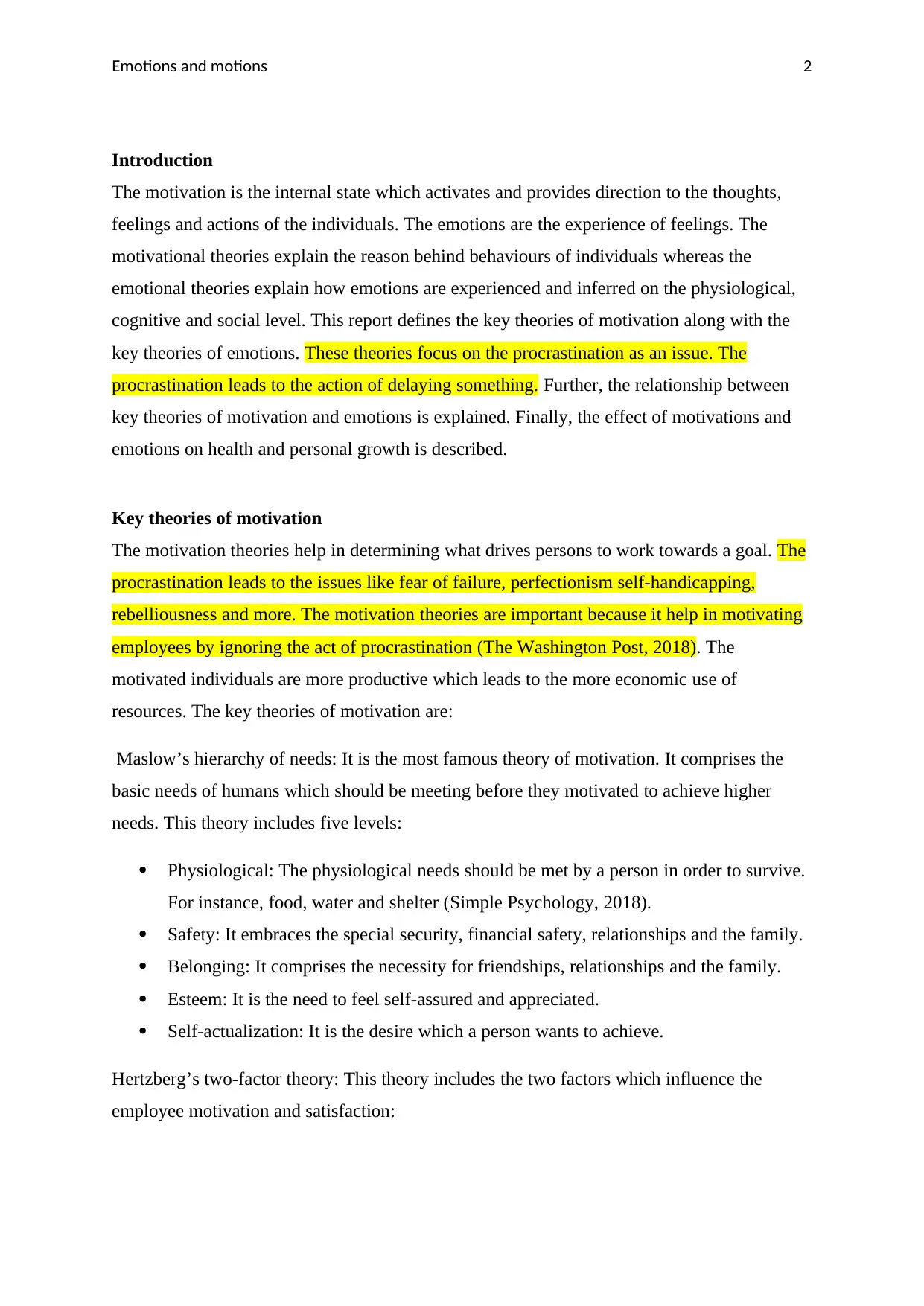
Emotions and motions 2
Introduction
The motivation is the internal state which activates and provides direction to the thoughts,
feelings and actions of the individuals. The emotions are the experience of feelings. The
motivational theories explain the reason behind behaviours of individuals whereas the
emotional theories explain how emotions are experienced and inferred on the physiological,
cognitive and social level. This report defines the key theories of motivation along with the
key theories of emotions. These theories focus on the procrastination as an issue. The
procrastination leads to the action of delaying something. Further, the relationship between
key theories of motivation and emotions is explained. Finally, the effect of motivations and
emotions on health and personal growth is described.
Key theories of motivation
The motivation theories help in determining what drives persons to work towards a goal. The
procrastination leads to the issues like fear of failure, perfectionism self-handicapping,
rebelliousness and more. The motivation theories are important because it help in motivating
employees by ignoring the act of procrastination (The Washington Post, 2018). The
motivated individuals are more productive which leads to the more economic use of
resources. The key theories of motivation are:
Maslow’s hierarchy of needs: It is the most famous theory of motivation. It comprises the
basic needs of humans which should be meeting before they motivated to achieve higher
needs. This theory includes five levels:
Physiological: The physiological needs should be met by a person in order to survive.
For instance, food, water and shelter (Simple Psychology, 2018).
Safety: It embraces the special security, financial safety, relationships and the family.
Belonging: It comprises the necessity for friendships, relationships and the family.
Esteem: It is the need to feel self-assured and appreciated.
Self-actualization: It is the desire which a person wants to achieve.
Hertzberg’s two-factor theory: This theory includes the two factors which influence the
employee motivation and satisfaction:
Introduction
The motivation is the internal state which activates and provides direction to the thoughts,
feelings and actions of the individuals. The emotions are the experience of feelings. The
motivational theories explain the reason behind behaviours of individuals whereas the
emotional theories explain how emotions are experienced and inferred on the physiological,
cognitive and social level. This report defines the key theories of motivation along with the
key theories of emotions. These theories focus on the procrastination as an issue. The
procrastination leads to the action of delaying something. Further, the relationship between
key theories of motivation and emotions is explained. Finally, the effect of motivations and
emotions on health and personal growth is described.
Key theories of motivation
The motivation theories help in determining what drives persons to work towards a goal. The
procrastination leads to the issues like fear of failure, perfectionism self-handicapping,
rebelliousness and more. The motivation theories are important because it help in motivating
employees by ignoring the act of procrastination (The Washington Post, 2018). The
motivated individuals are more productive which leads to the more economic use of
resources. The key theories of motivation are:
Maslow’s hierarchy of needs: It is the most famous theory of motivation. It comprises the
basic needs of humans which should be meeting before they motivated to achieve higher
needs. This theory includes five levels:
Physiological: The physiological needs should be met by a person in order to survive.
For instance, food, water and shelter (Simple Psychology, 2018).
Safety: It embraces the special security, financial safety, relationships and the family.
Belonging: It comprises the necessity for friendships, relationships and the family.
Esteem: It is the need to feel self-assured and appreciated.
Self-actualization: It is the desire which a person wants to achieve.
Hertzberg’s two-factor theory: This theory includes the two factors which influence the
employee motivation and satisfaction:
⊘ This is a preview!⊘
Do you want full access?
Subscribe today to unlock all pages.

Trusted by 1+ million students worldwide
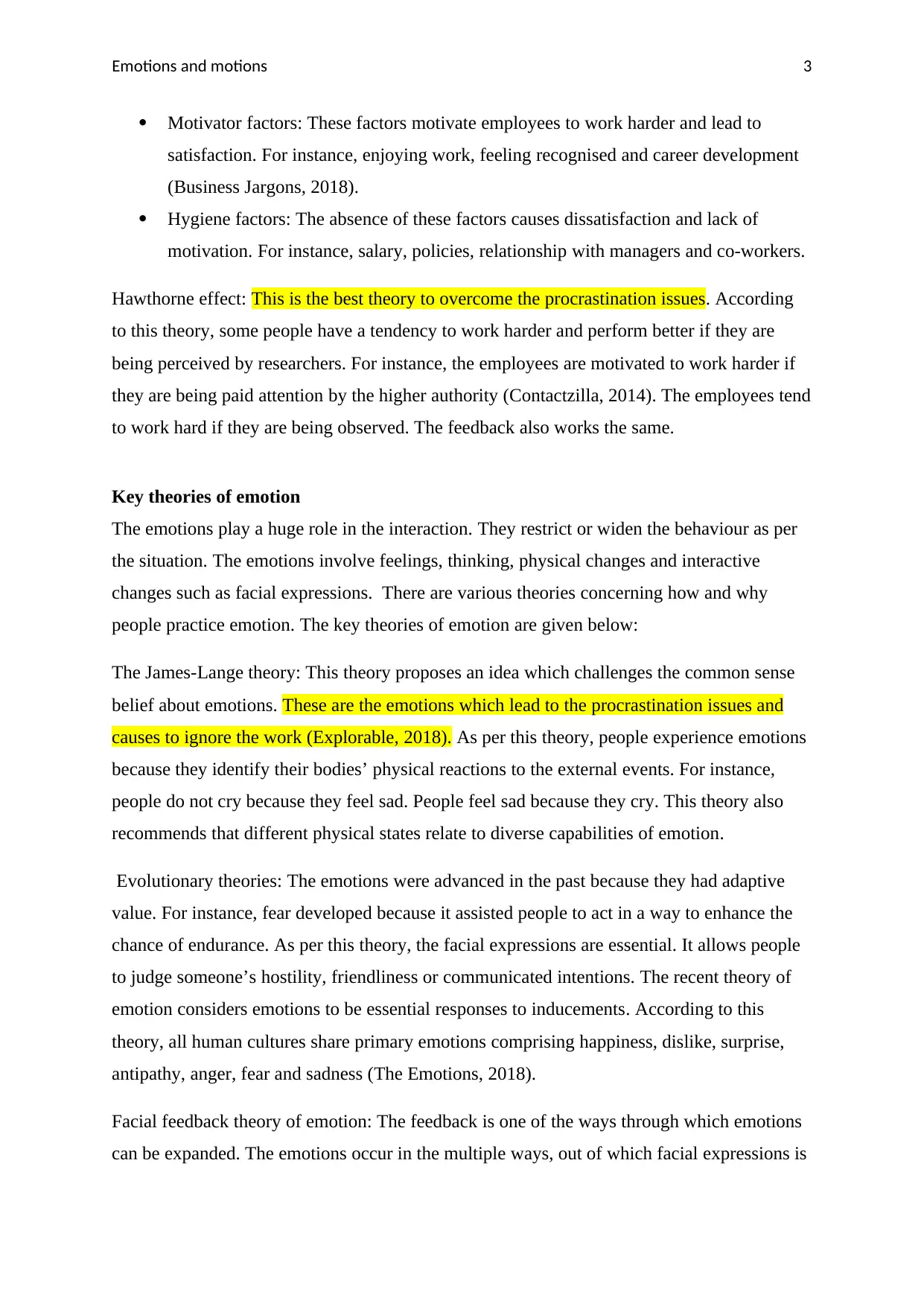
Emotions and motions 3
Motivator factors: These factors motivate employees to work harder and lead to
satisfaction. For instance, enjoying work, feeling recognised and career development
(Business Jargons, 2018).
Hygiene factors: The absence of these factors causes dissatisfaction and lack of
motivation. For instance, salary, policies, relationship with managers and co-workers.
Hawthorne effect: This is the best theory to overcome the procrastination issues. According
to this theory, some people have a tendency to work harder and perform better if they are
being perceived by researchers. For instance, the employees are motivated to work harder if
they are being paid attention by the higher authority (Contactzilla, 2014). The employees tend
to work hard if they are being observed. The feedback also works the same.
Key theories of emotion
The emotions play a huge role in the interaction. They restrict or widen the behaviour as per
the situation. The emotions involve feelings, thinking, physical changes and interactive
changes such as facial expressions. There are various theories concerning how and why
people practice emotion. The key theories of emotion are given below:
The James-Lange theory: This theory proposes an idea which challenges the common sense
belief about emotions. These are the emotions which lead to the procrastination issues and
causes to ignore the work (Explorable, 2018). As per this theory, people experience emotions
because they identify their bodies’ physical reactions to the external events. For instance,
people do not cry because they feel sad. People feel sad because they cry. This theory also
recommends that different physical states relate to diverse capabilities of emotion.
Evolutionary theories: The emotions were advanced in the past because they had adaptive
value. For instance, fear developed because it assisted people to act in a way to enhance the
chance of endurance. As per this theory, the facial expressions are essential. It allows people
to judge someone’s hostility, friendliness or communicated intentions. The recent theory of
emotion considers emotions to be essential responses to inducements. According to this
theory, all human cultures share primary emotions comprising happiness, dislike, surprise,
antipathy, anger, fear and sadness (The Emotions, 2018).
Facial feedback theory of emotion: The feedback is one of the ways through which emotions
can be expanded. The emotions occur in the multiple ways, out of which facial expressions is
Motivator factors: These factors motivate employees to work harder and lead to
satisfaction. For instance, enjoying work, feeling recognised and career development
(Business Jargons, 2018).
Hygiene factors: The absence of these factors causes dissatisfaction and lack of
motivation. For instance, salary, policies, relationship with managers and co-workers.
Hawthorne effect: This is the best theory to overcome the procrastination issues. According
to this theory, some people have a tendency to work harder and perform better if they are
being perceived by researchers. For instance, the employees are motivated to work harder if
they are being paid attention by the higher authority (Contactzilla, 2014). The employees tend
to work hard if they are being observed. The feedback also works the same.
Key theories of emotion
The emotions play a huge role in the interaction. They restrict or widen the behaviour as per
the situation. The emotions involve feelings, thinking, physical changes and interactive
changes such as facial expressions. There are various theories concerning how and why
people practice emotion. The key theories of emotion are given below:
The James-Lange theory: This theory proposes an idea which challenges the common sense
belief about emotions. These are the emotions which lead to the procrastination issues and
causes to ignore the work (Explorable, 2018). As per this theory, people experience emotions
because they identify their bodies’ physical reactions to the external events. For instance,
people do not cry because they feel sad. People feel sad because they cry. This theory also
recommends that different physical states relate to diverse capabilities of emotion.
Evolutionary theories: The emotions were advanced in the past because they had adaptive
value. For instance, fear developed because it assisted people to act in a way to enhance the
chance of endurance. As per this theory, the facial expressions are essential. It allows people
to judge someone’s hostility, friendliness or communicated intentions. The recent theory of
emotion considers emotions to be essential responses to inducements. According to this
theory, all human cultures share primary emotions comprising happiness, dislike, surprise,
antipathy, anger, fear and sadness (The Emotions, 2018).
Facial feedback theory of emotion: The feedback is one of the ways through which emotions
can be expanded. The emotions occur in the multiple ways, out of which facial expressions is
Paraphrase This Document
Need a fresh take? Get an instant paraphrase of this document with our AI Paraphraser
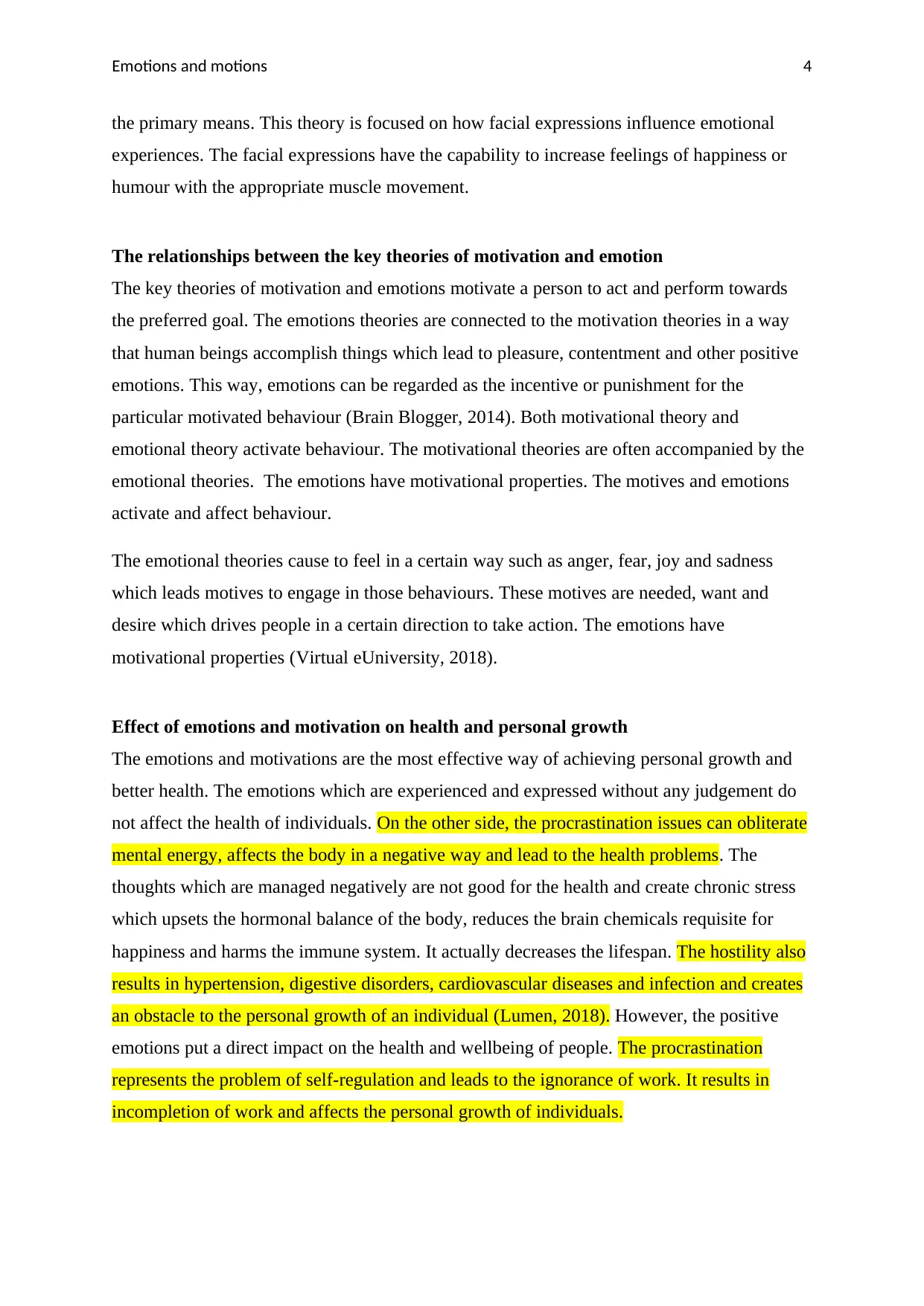
Emotions and motions 4
the primary means. This theory is focused on how facial expressions influence emotional
experiences. The facial expressions have the capability to increase feelings of happiness or
humour with the appropriate muscle movement.
The relationships between the key theories of motivation and emotion
The key theories of motivation and emotions motivate a person to act and perform towards
the preferred goal. The emotions theories are connected to the motivation theories in a way
that human beings accomplish things which lead to pleasure, contentment and other positive
emotions. This way, emotions can be regarded as the incentive or punishment for the
particular motivated behaviour (Brain Blogger, 2014). Both motivational theory and
emotional theory activate behaviour. The motivational theories are often accompanied by the
emotional theories. The emotions have motivational properties. The motives and emotions
activate and affect behaviour.
The emotional theories cause to feel in a certain way such as anger, fear, joy and sadness
which leads motives to engage in those behaviours. These motives are needed, want and
desire which drives people in a certain direction to take action. The emotions have
motivational properties (Virtual eUniversity, 2018).
Effect of emotions and motivation on health and personal growth
The emotions and motivations are the most effective way of achieving personal growth and
better health. The emotions which are experienced and expressed without any judgement do
not affect the health of individuals. On the other side, the procrastination issues can obliterate
mental energy, affects the body in a negative way and lead to the health problems. The
thoughts which are managed negatively are not good for the health and create chronic stress
which upsets the hormonal balance of the body, reduces the brain chemicals requisite for
happiness and harms the immune system. It actually decreases the lifespan. The hostility also
results in hypertension, digestive disorders, cardiovascular diseases and infection and creates
an obstacle to the personal growth of an individual (Lumen, 2018). However, the positive
emotions put a direct impact on the health and wellbeing of people. The procrastination
represents the problem of self-regulation and leads to the ignorance of work. It results in
incompletion of work and affects the personal growth of individuals.
the primary means. This theory is focused on how facial expressions influence emotional
experiences. The facial expressions have the capability to increase feelings of happiness or
humour with the appropriate muscle movement.
The relationships between the key theories of motivation and emotion
The key theories of motivation and emotions motivate a person to act and perform towards
the preferred goal. The emotions theories are connected to the motivation theories in a way
that human beings accomplish things which lead to pleasure, contentment and other positive
emotions. This way, emotions can be regarded as the incentive or punishment for the
particular motivated behaviour (Brain Blogger, 2014). Both motivational theory and
emotional theory activate behaviour. The motivational theories are often accompanied by the
emotional theories. The emotions have motivational properties. The motives and emotions
activate and affect behaviour.
The emotional theories cause to feel in a certain way such as anger, fear, joy and sadness
which leads motives to engage in those behaviours. These motives are needed, want and
desire which drives people in a certain direction to take action. The emotions have
motivational properties (Virtual eUniversity, 2018).
Effect of emotions and motivation on health and personal growth
The emotions and motivations are the most effective way of achieving personal growth and
better health. The emotions which are experienced and expressed without any judgement do
not affect the health of individuals. On the other side, the procrastination issues can obliterate
mental energy, affects the body in a negative way and lead to the health problems. The
thoughts which are managed negatively are not good for the health and create chronic stress
which upsets the hormonal balance of the body, reduces the brain chemicals requisite for
happiness and harms the immune system. It actually decreases the lifespan. The hostility also
results in hypertension, digestive disorders, cardiovascular diseases and infection and creates
an obstacle to the personal growth of an individual (Lumen, 2018). However, the positive
emotions put a direct impact on the health and wellbeing of people. The procrastination
represents the problem of self-regulation and leads to the ignorance of work. It results in
incompletion of work and affects the personal growth of individuals.

Emotions and motions 5
The motivation ignores the procrastination issues and leads to the personal growth as it
connects to the goals and purposes. The personal growth leads to the growth, maturity,
success and happiness. It also spread awareness for the possible opportunities around. The
motivation helps to cope up with the stress which prevents illness and promotes good health
(Reeve, 2014). The motivation helps to set goals and fix problems which as a result promote
better mental and physical health.
Conclusion
The motivation is a force which energises, activates and directs behaviour. It provides
direction and persistence to the individual’s behaviour. The emotions predict the behaviour of
a person. The emotions represent the procrastination issues such as lying to himself and no
willingness to work. The emotions and motivations are linked to each other as motives are
usually accompanied by the emotions. In this report, the theories of motivation and emotions
have been explained which helps to resolve procrastination issues. There is a relationship
between the key theories of motivation and emotions which is supported by the facts
explained above. At last, the effect of emotions and motivations on the health and personal
growth is discussed which is supported by both positive and negative aspects.
The motivation ignores the procrastination issues and leads to the personal growth as it
connects to the goals and purposes. The personal growth leads to the growth, maturity,
success and happiness. It also spread awareness for the possible opportunities around. The
motivation helps to cope up with the stress which prevents illness and promotes good health
(Reeve, 2014). The motivation helps to set goals and fix problems which as a result promote
better mental and physical health.
Conclusion
The motivation is a force which energises, activates and directs behaviour. It provides
direction and persistence to the individual’s behaviour. The emotions predict the behaviour of
a person. The emotions represent the procrastination issues such as lying to himself and no
willingness to work. The emotions and motivations are linked to each other as motives are
usually accompanied by the emotions. In this report, the theories of motivation and emotions
have been explained which helps to resolve procrastination issues. There is a relationship
between the key theories of motivation and emotions which is supported by the facts
explained above. At last, the effect of emotions and motivations on the health and personal
growth is discussed which is supported by both positive and negative aspects.
⊘ This is a preview!⊘
Do you want full access?
Subscribe today to unlock all pages.

Trusted by 1+ million students worldwide
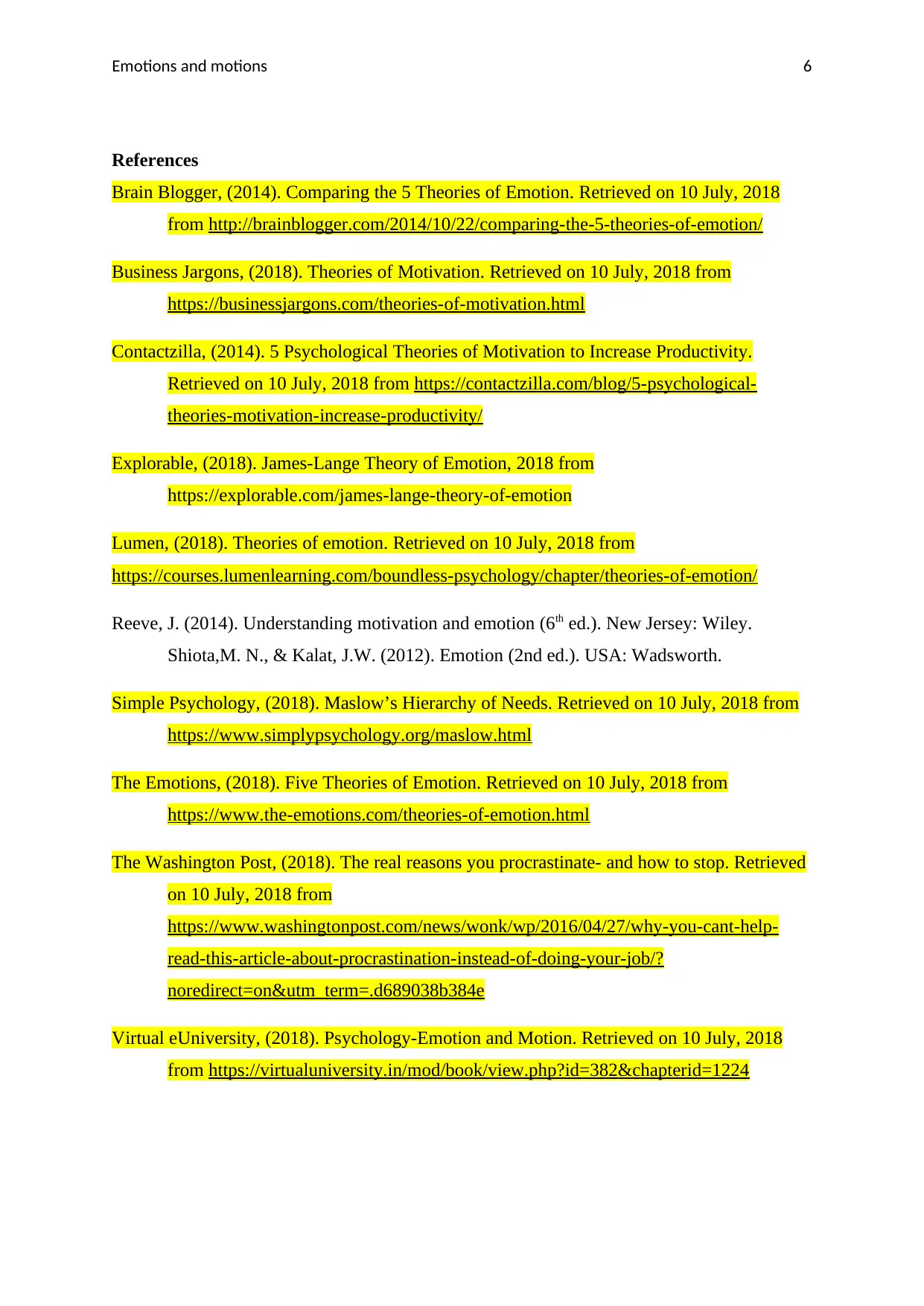
Emotions and motions 6
References
Brain Blogger, (2014). Comparing the 5 Theories of Emotion. Retrieved on 10 July, 2018
from http://brainblogger.com/2014/10/22/comparing-the-5-theories-of-emotion/
Business Jargons, (2018). Theories of Motivation. Retrieved on 10 July, 2018 from
https://businessjargons.com/theories-of-motivation.html
Contactzilla, (2014). 5 Psychological Theories of Motivation to Increase Productivity.
Retrieved on 10 July, 2018 from https://contactzilla.com/blog/5-psychological-
theories-motivation-increase-productivity/
Explorable, (2018). James-Lange Theory of Emotion, 2018 from
https://explorable.com/james-lange-theory-of-emotion
Lumen, (2018). Theories of emotion. Retrieved on 10 July, 2018 from
https://courses.lumenlearning.com/boundless-psychology/chapter/theories-of-emotion/
Reeve, J. (2014). Understanding motivation and emotion (6th ed.). New Jersey: Wiley.
Shiota,M. N., & Kalat, J.W. (2012). Emotion (2nd ed.). USA: Wadsworth.
Simple Psychology, (2018). Maslow’s Hierarchy of Needs. Retrieved on 10 July, 2018 from
https://www.simplypsychology.org/maslow.html
The Emotions, (2018). Five Theories of Emotion. Retrieved on 10 July, 2018 from
https://www.the-emotions.com/theories-of-emotion.html
The Washington Post, (2018). The real reasons you procrastinate- and how to stop. Retrieved
on 10 July, 2018 from
https://www.washingtonpost.com/news/wonk/wp/2016/04/27/why-you-cant-help-
read-this-article-about-procrastination-instead-of-doing-your-job/?
noredirect=on&utm_term=.d689038b384e
Virtual eUniversity, (2018). Psychology-Emotion and Motion. Retrieved on 10 July, 2018
from https://virtualuniversity.in/mod/book/view.php?id=382&chapterid=1224
References
Brain Blogger, (2014). Comparing the 5 Theories of Emotion. Retrieved on 10 July, 2018
from http://brainblogger.com/2014/10/22/comparing-the-5-theories-of-emotion/
Business Jargons, (2018). Theories of Motivation. Retrieved on 10 July, 2018 from
https://businessjargons.com/theories-of-motivation.html
Contactzilla, (2014). 5 Psychological Theories of Motivation to Increase Productivity.
Retrieved on 10 July, 2018 from https://contactzilla.com/blog/5-psychological-
theories-motivation-increase-productivity/
Explorable, (2018). James-Lange Theory of Emotion, 2018 from
https://explorable.com/james-lange-theory-of-emotion
Lumen, (2018). Theories of emotion. Retrieved on 10 July, 2018 from
https://courses.lumenlearning.com/boundless-psychology/chapter/theories-of-emotion/
Reeve, J. (2014). Understanding motivation and emotion (6th ed.). New Jersey: Wiley.
Shiota,M. N., & Kalat, J.W. (2012). Emotion (2nd ed.). USA: Wadsworth.
Simple Psychology, (2018). Maslow’s Hierarchy of Needs. Retrieved on 10 July, 2018 from
https://www.simplypsychology.org/maslow.html
The Emotions, (2018). Five Theories of Emotion. Retrieved on 10 July, 2018 from
https://www.the-emotions.com/theories-of-emotion.html
The Washington Post, (2018). The real reasons you procrastinate- and how to stop. Retrieved
on 10 July, 2018 from
https://www.washingtonpost.com/news/wonk/wp/2016/04/27/why-you-cant-help-
read-this-article-about-procrastination-instead-of-doing-your-job/?
noredirect=on&utm_term=.d689038b384e
Virtual eUniversity, (2018). Psychology-Emotion and Motion. Retrieved on 10 July, 2018
from https://virtualuniversity.in/mod/book/view.php?id=382&chapterid=1224
1 out of 7
Related Documents
Your All-in-One AI-Powered Toolkit for Academic Success.
+13062052269
info@desklib.com
Available 24*7 on WhatsApp / Email
![[object Object]](/_next/static/media/star-bottom.7253800d.svg)
Unlock your academic potential
Copyright © 2020–2025 A2Z Services. All Rights Reserved. Developed and managed by ZUCOL.



